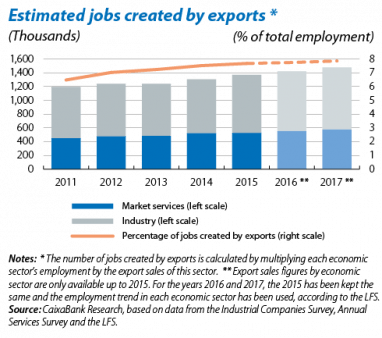Exports’ positive effect on job creation
The rise in Spanish exports has significantly boosted the labour market. Nevertheless, it is quite complicated to quantify just how many jobs have been created by the export boom. To calculate the number of jobs that can be attributed to all exports during the most recent period we have used data from the Industrial Companies Survey and the Annual Services Survey for the years 2011 to 2015 (the latest survey available). Each sector’s employment has been distributed according to its share of domestic and foreign demand based on its percentage of sales abroad.1 For the years 2016 and 2017, we have used each sector’s employment trend according to the LFS.2 Note that this calculation assumes labour productivity is the same across all companies in the same sector. The results obtained must therefore be seen as an approximation, although the detail provided by the 2-digit National Classification of Economic Activities (CNAE) means our analysis is relatively reliable. It should also be noted that this calculation does not take into account the effects on other sectors produced by a certain sector’s increase in exports.
Although this calculation is relatively simplistic, it does help to illustrate that the export boom is having a very positive effect on employment. Specifically, during the recessionary period of 2011-2013, exports created around 46,000 jobs. This was more than offset by the slump in domestic demand, destroying 502,000 jobs, so the net loss was 456,000 jobs. This period is notable for the stronger trend in service exports than for industrial sectors, with the technical service sectors of architecture and engineering performing particularly well (+14,000 jobs, contributing 30% to all the jobs created by exports) as well as programming, consultancy and computing (+8,000 jobs, a 16% share). Among the industrial sectors, the manufacture of other transport equipment (+11,000, 23% share) and the food industry (+7,000, 15% share) performed particularly well.
During the current recovery phase, from 2013 to 2017, it is estimated that exports created around 239,000 jobs, a 14% share of all the employment created in this period. This figure proves that the opening up of international trade is an opportunity for job creation. Services have continued to perform well, with 94,000 jobs, but industry has contributed most of the export-related jobs (146,000). In fact, industry’s contribution during this period is doubly important because, at the same time, considerable increases in apparent labour productivity have been posted by most sectors.
1. Specifically, we have data from 32 service and 22 industrial sectors, at 2 digits, corresponding to the following CNAE codes: B, C, D, E, H, I, J, L, M, N, R and S, accounting for 44% of all employees in 2017. Export sales figures by economic activity are only available up to 2015. Note that this calculation does not use input-output tables. Consequently, it does not take into account employment resulting from other economic sectors supplying the intermediate products used in producing the exported goods and services.
2. It is assumed that the share of export sales remains at the level of 2015.




